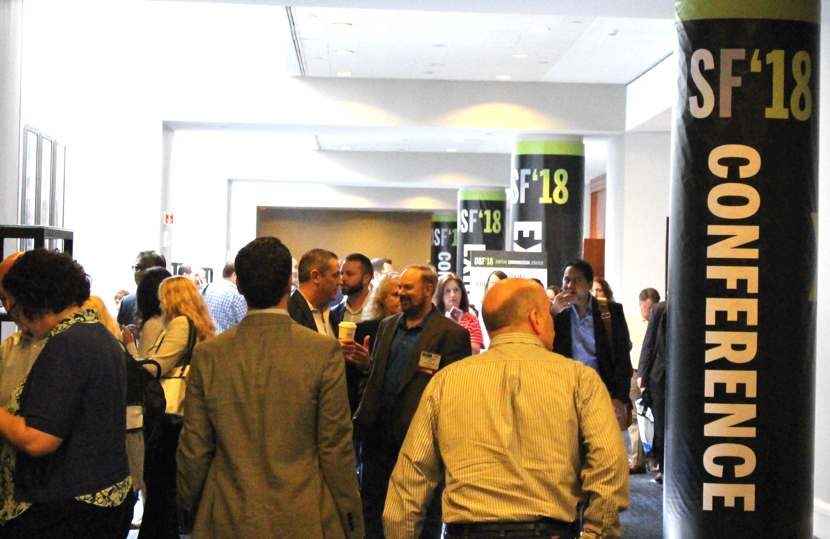
©2018 DOCUMENT Strategy Forum
While every DOCUMENT Strategy Forum (DSF) conference is a great learning and sharing experience for those of us who own, execute, and manage customer communications, this last one in Boston marked a real shift in focus critical to our future success—a shift in perspective around adopting a customer-centric view.
The panel discussions, keynotes, and breakout sessions all showed metrics demonstrating the impact that communications have on the overall customer experience. While this message has been gaining mindshare over the past few years, it appears that we are finally beginning to understand the interconnectedness of our communication projects and their impact on the customer experience.
I believe this is a breakthrough for our industry.
I heard speakers and attendees alike talking about how one communication can directly impact a customer’s experience as it relates to another communication they receive. I had some very practical discussions at lunch (special shout out for that chocolate cake dessert) about how document experts are actively meeting with other teams in the organization to tackle some of the bungled handoffs, mixed messages, and unmet expectations that plague these communications.
At the 2016 event, I presented a session that included an exercise in creating a rough customer journey map. At this year’s event, I heard from many attendees who have since actively participated in customer journey mapping workshops. That is a very important step, and it was refreshing to hear people share their stories. The journey mapping process can reveal a wide variety of issues that need to be addressed. These sessions alone can often bring up hundreds of challenges. After customer journey mapping, organizations will need to work on prioritizing their projects. From the discussions at DSF, I believe we have some breakthrough thinking on this important step across the industry.
At the 2016 event, I presented a session that included an exercise in creating a rough customer journey map. At this year’s event, I heard from many attendees who have since actively participated in customer journey mapping workshops. That is a very important step, and it was refreshing to hear people share their stories. The journey mapping process can reveal a wide variety of issues that need to be addressed. These sessions alone can often bring up hundreds of challenges. After customer journey mapping, organizations will need to work on prioritizing their projects. From the discussions at DSF, I believe we have some breakthrough thinking on this important step across the industry.
This year, some of the sessions covered advanced concepts in areas like analytics, recommendation, and automation to help speed our communications, while others featured success stories from companies that centralized their communications and even changed budgeting processes to align with customer experience improvements.
A few of the advanced companies at the conference are starting to turn these strategic initiatives into programs, reducing the number of moving parts in their communication ecosystems. This includes some major decisions, like a willingness to replace systems that have remained untouched for years. I saw a real change in thinking around migration. In the past, when a company was considering migrating from a legacy system, a key criterion for the new solution was ensuring it produced identical communications. As we added new channels over the years, we understood the need for new design standards optimized for these channels. We let the new channels play by new rules, while forcing legacy systems to play by the old rules.
Innovative thinkers at DSF are starting to shake the concept of “parallel testing,” which led many to design new communication systems within constraints that no longer existed. As channels become centralized within omni-channel systems, designs are improving at a fast pace. This is a natural consequence of this new thinking, because we know upgrading “like for like” documents generates “like for like” results.
As we focus on the impact of the documents we create on the customer experience, we are finding new opportunities to improve the contributions we make to our companies. Designing communications that are consistent across the customer’s journey can improve customer experience, increase top-line revenue, and decrease operational costs.
When we think about the upstream and downstream impact of the projects we manage, we begin to understand different perspectives within the organization. This provides us insight so that we can help other teams to optimize their analytics strategies, wrestle with new compliance requirements, engineer omni-channel archive strategies, and support the employee systems that, in turn, support customer touchpoints.
The amount of discussion on these topics at DSF was refreshing, but not as refreshing as the smiles that people had when talking about some of these discoveries. In previous years, we seemed a bit afraid of the challenge, because we saw no end to the scope of problems we were facing. However, we are now starting to see solutions emerge, which means we have the opportunity to learn new ways of doing things as we implement those solutions. I look forward to next year’s DSF where we will see some of the results on these large-scope, customer-centric projects.
Scott Draeger is Vice President of Product Management at Quadient. He joined the digital document industry in 1997, after graduating from UNLV. He started as a document designer using a collection of hardware and software technologies, before moving to the software side of the industry. His broad experience includes helping clients improve customer communications in over 20 countries. For more information, visit www.quadient.com or follow him on Twitter @scottdraeger.






